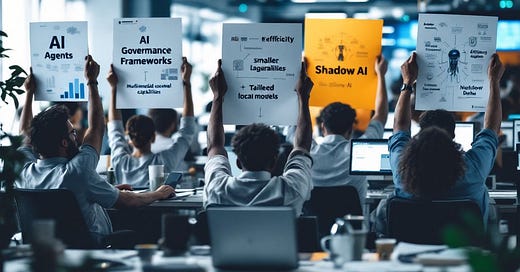Industry events, major announcements, analyst insights, and market discussions inform this overview of current AI trends. Key trends reshaping the AI landscape include AI agents, governance frameworks, multimodal capabilities, more efficient smaller language models, tailored local models, and the emergence of Shadow AI.
Agentic AI is a key major focus in today’s new product development. Agents aim at boosting productivity through systems capable of acting autonomously, from handling simple micro-automations to managing complex projects. CIOs leverage this technology to automate customer interactions and enhance decision-making through swift data analysis. Within enterprises, AI agents serve as virtual team members, improving collaboration and overall team performance. As AI advances from basic, reactive chatbots to sophisticated systems with independent, proactive planning capabilities, it underscores that we are still in the early phases of AI development. This evolution highlights the importance of strategic governance to balance AI autonomy and proper oversight.
AI Governance platforms are essential for ensuring the responsible, transparent, and ethical development and deployment of AI. They help IT leaders uphold reliability, fairness, and accountability while addressing risks such as bias, privacy concerns, and ethical breaches, especially in regulated sectors like financial services. These platforms enforce standards throughout the AI lifecycle, from assessing risks to auditing decision-making and monitoring performance. As AI use grows, governance frameworks safeguard user data, ensure compliance, and prevent harmful outcomes, providing the necessary oversight to mitigate risks and promote ethical AI practices in a rapidly advancing landscape.
Multimodal AI refers to advanced AI systems that can understand and generate multiple types of data, such as text, images, audio, and video, in a unified way. This capability allows AI to deliver more natural and interactive user experiences, as it can seamlessly integrate different modes of information. For instance, a model like Google’s Lumiere uses diffusion techniques to generate videos from textual descriptions, opening up possibilities in content creation, education, and entertainment. These models can be transformative in scenarios like video-based training simulations or visual content generation, where the interplay of various data formats is crucial.
Smaller Language Models are at the forefront of AI research, aiming to create highly efficient models that deliver strong performance while consuming less computational power and energy. This makes AI more sustainable and accessible, particularly for organizations with limited resources. Innovations like Mistral's Mixtral and Meta's Llama 3 are paving the way, demonstrating that smaller models can achieve comparable performance to their larger counterparts. These efficient models enable broader adoption across industries, supporting real-time applications, reducing infrastructure costs, and minimizing environmental impact.
Customized Local Models empower organizations to build and deploy AI solutions tailored to their needs by leveraging open-source models and proprietary data. This approach allows companies to fine-tune models to optimize for their unique workflows, data patterns, and security requirements. By developing local models, enterprises can reduce reliance on third-party services, lowering costs and enhancing data security and privacy. This strategy is effective for sectors like healthcare and finance, where data sensitivity and regulatory compliance are paramount.
Shadow AI refers to employees' unauthorized or unsanctioned use of AI technologies within an organization. This phenomenon presents serious challenges, including risks to data privacy, security vulnerabilities, and potential breaches of compliance regulations. The rise of Shadow AI highlights the need for companies to proactively establish comprehensive policies, oversight mechanisms, and governance frameworks. By addressing these concerns, organizations can mitigate risks and ensure that AI usage aligns with corporate guidelines, fostering a safer and more controlled environment for AI innovation.
Conclusion
While AI trends promise innovation, real-world challenges persist. Agentic AI's autonomy could lead to unpredictable actions and hard-to-explain decisions. Governance platforms, while necessary, are costly and need help to match AI's rapid evolution. Multimodal and smaller language models often falter in real-world scenarios with inconsistent data, and customized models, though secure, require resources that many organizations need more. Shadow AI remains a significant risk, as employees may bypass security measures for convenience, undermining compliance efforts.




